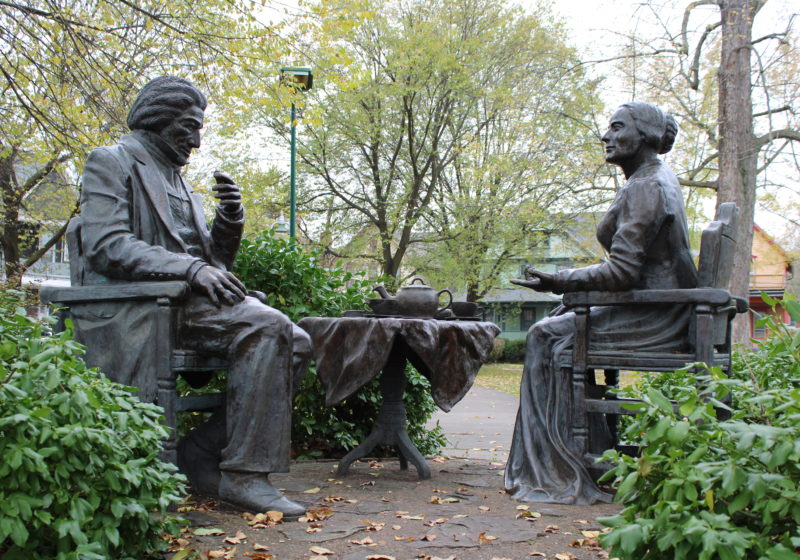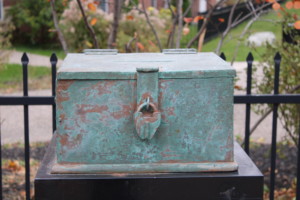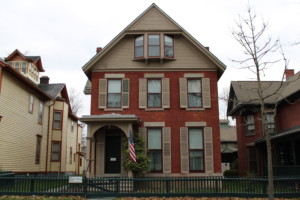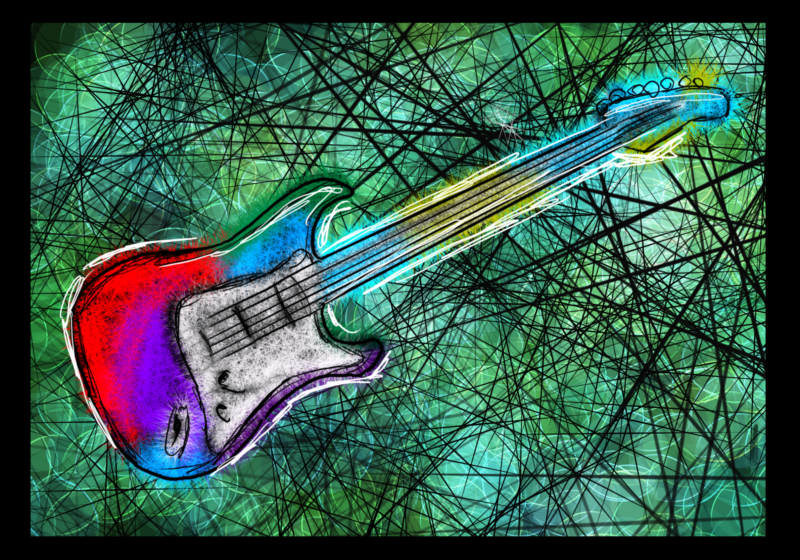Squinting against the flurry of Rochester’s first snow outside of 1872 cafe, I look around until — there, in front of the garden gates: the ballot box where suffragist and abolitionist Susan B. Anthony illegally voted in the 1872 election.
Feet numb from the cold, I hobble over to stare at its grey-green marble. My emotions swing like a pendulum from pride, to pain, and back again. It’s apt that I’m torn, because the dilemma in question unnaturally splits me between my womanhood and my blackness.
What should I feel towards a woman whose fierce battling paved the way for that first part of me while sacrificing the other on a spit?
———
A couple hours before I stood staring at that ballot box, I toured Susan B. Anthony’s house with my guide, Jane: a warm woman with a ring on almost every finger. The preserved red-brick house sits in a quiet, Victorian-styled suburb in the Susan B. Anthony neighborhood.
An American flag decorates the doorway of Anthony’s house, 19 Madison Street.
A tall, unflashy house, its decor is equally modest. I’d like to tell you there was intricate detail and fascinating furniture, but all the rooms seemed perfunctory — some chairs, some tables. Given Anthony’s Quaker upbringing, the simplicity seemed fitting.
The Anthony front parlor, where they would typically entertain guests, is where she was arrested days after illegally voting in 1872. The police officer told her that she didn’t have to come with him in broad daylight, but should pop in when it was convenient. Anthony politely refused. Instead, she donned a nice dress and rode the public trolley down to the station in handcuffs. It’s said she would have stayed in jail if they’d let her. (Her lawyer didn’t think it proper or necessary.)
The judge prohibited her from testifying and directed the jury to give a guilty verdict. She was found guilty and asked to pay a $100 penalty. When the judge, having delivered his verdict, asked her if she had any final words, she seized the moment to deliver her now famous speech. The title and central question: “Is it a crime,” she asked, “for a citizen of the United States to vote?”
Her strong opinions seemed a source of amusement and fear for some. The Daily Graphic put a drawing of her on their front page in 1873 — or more accurately, a caricature of her looking stern and mannish with a lopsided Uncle Sam hat. Surrounding her were scenes depicting the consequences of women’s suffrage. Men might look after their babies! Or go grocery shopping! Women might become cops! Quelle horreur.
Anthony would not live to see women in every state get the right to vote, nor the day when those satirical predictions of the Daily Graphic would materialize. But when the 19th Amendment was ratified in 1920, it was named the Susan B. Anthony Amendment.
———
Green curtains section off the living room — a more intimate space — from the front parlor. On the mantle rests a framed picture of Frederick Douglass, Rochester’s other esteemed celebrity, and Anthony’s friend.
Douglass considered himself “a woman’s rights man” (a novel perspective), and attended the first women’s rights convention in Seneca. Here, he spoke in favor of famed suffragist Elizabeth Cady Stanton’s desire to add the vote to the women’s list of declarations, though many women felt getting political would be a step too far.
Anthony traveled with Douglass around New York, giving speeches. They were run out of Buffalo — a doll in Anthony’s likeness was hanged in Syracuse. Douglass once broke his hand escaping from a town mob.
It takes me a while to ask Jane my question, even though I can’t imagine I’m the first. Partly, I hoped the issue would come up on its own. Partly, I just don’t want to be the black person who makes it about race. But that is who I am, and so when Jane asks if I have any last questions, I ask, in apologetic tones, about the rift that, for years, splintered Douglass and Anthony’s friendship.
———
With the 1868 passing of the 14th Amendment, solidarity between the black and suffragist movements began to crack.
The problem lay with section two, which goes through rules about how to assign House representatives according to population size. It casually references “male inhabitants” when setting those rules, making it clear that when legislators referred to the rights of a “person,” they meant only men.
Furious to be excluded, but cognizant that at least one half of their joint fight was making progress, Anthony and Stanton were conflicted. But the internal debates ended with the 15th Amendment of 1870, which explicitly gave all men of color — and not a single woman — the right to vote. The ensuing spat between Anthony, Stanton, and Douglass is well-documented.
Anthony and Stanton wanted suffrage for everyone, or no one. “I will cut off this right arm of mine before I will ever work for or demand the ballot for the Negro and not for the woman,” Anthony declared.
Douglass urged that they accept the compromise, because he felt it would be impossible to get both demands passed at once and because he said black men sorely needed this protection.
“When women, because they are women, are hunted down through the cities of New York and New Orleans; when they are dragged from their houses and hung upon lamp-posts; when their children are torn from their arms, and their brains dashed out upon the pavement; when they are objects of insult and outrage at every turn; when they are in danger of having their homes burnt down over their heads, when their children are not allowed to enter schools; then [women] will have an urgency to obtain the ballot equal to our own,” he famously retorted.
When I found that quote, I wished I had been inside Douglass’ head. To be sure, the experiences he detailed did not apply to the white women he was arguing with. But were the black women who had birthed these children he cited among his consideration? Did racism somehow overlook them?
By the end of it, Anthony and Stanton created a new organization, the National Woman Suffrage Association, that would detach the fight for women’s suffrage from the racial equality fight.
———
Jane nods as I speak of this. We agree there’s no defending what was said. She is sympathetic, though, to the women’s anger at the lack of fruition for their life’s work.
“Wouldn’t you be angry?” she asks me. I want to ask her: with who?
In much of the online rhetoric, Anthony is perceived as the bad guy. She and Stanton refused to compromise and revealed their racist tendencies, whereas Douglass emerges the hero who never stopped supporting women’s rights.
But amidst this fight, black women are relevant only in the way a child is relevant to a divorce. Forgotten in the heat of things, and at other times, whipped out like a weapon of war. Stanton, for one, flip-flopped between using black women to prove that women deserved the vote and degrading men of color as “Patricks and Sambos” who couldn’t tell a monarchy from a republic.
In this city that once housed crusaders of two valiant fights, neither had fought for me.
———
My musings on this slice of beautiful, tainted history may not sound like a strong recommendation, but it’s one of the best I could give. In today’s cancel culture Twitter territory, the story could easily become Frederick Douglass was sexist and Susan B. Anthony was racist, so everyone should stop buying their books.
But their history rejects simple narratives to reveal something grittier: contradiction co-existing just as it always has, though we are loathe to admit it.
———
Displayed on the walls of Anthony’s guest bedroom are portraits of some of the women whom she hosted there. Among them is Ida B. Wells-Barnett, a black female journalist and anti-lynching activist who stayed with Anthony on two occasions.
Wells-Barnett attended the historic 1913 women’s suffrage parade, which was so successful, it stole all the attention from then-President Woodrow Wilson who had arrived in D.C. earlier that day. But because organizers feared that white women would not march alongside black women, they relegated black women to the back.
Except for Ida B. Wells-Barnett. She forced her way between two white supporters and refused to participate unless she could “march under the Illinois banner.” And that is what she did.
———
Back at the ballot box, it’s when I think of Ida that my oscillating emotions finally find their center. And the snow abates, just enough for me to appreciate the sun peeking through, turning the smattering of leaves in the garden golden.









